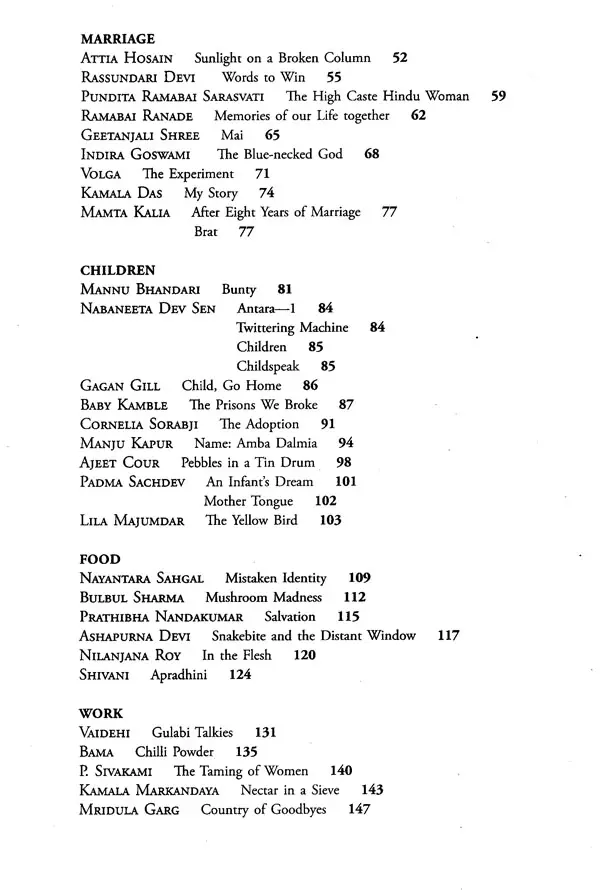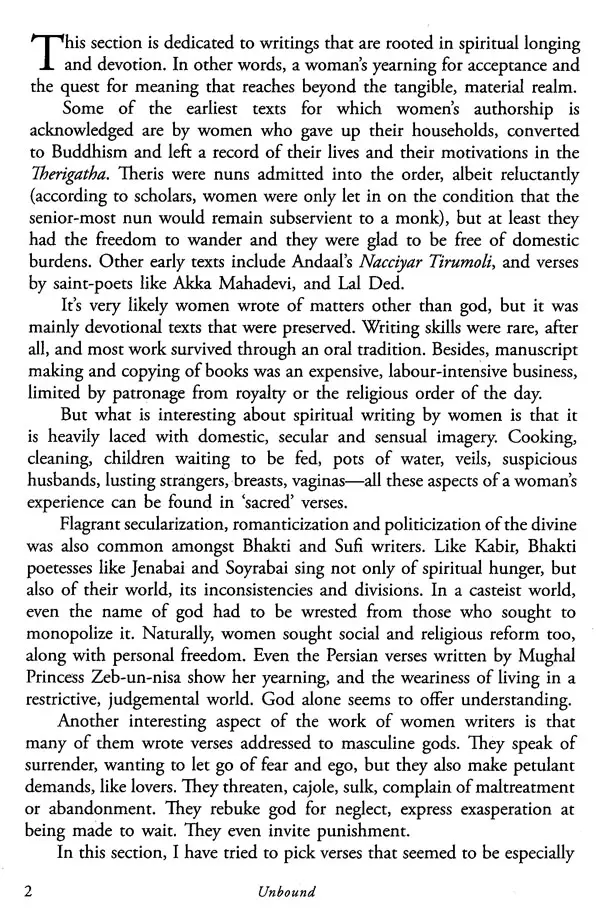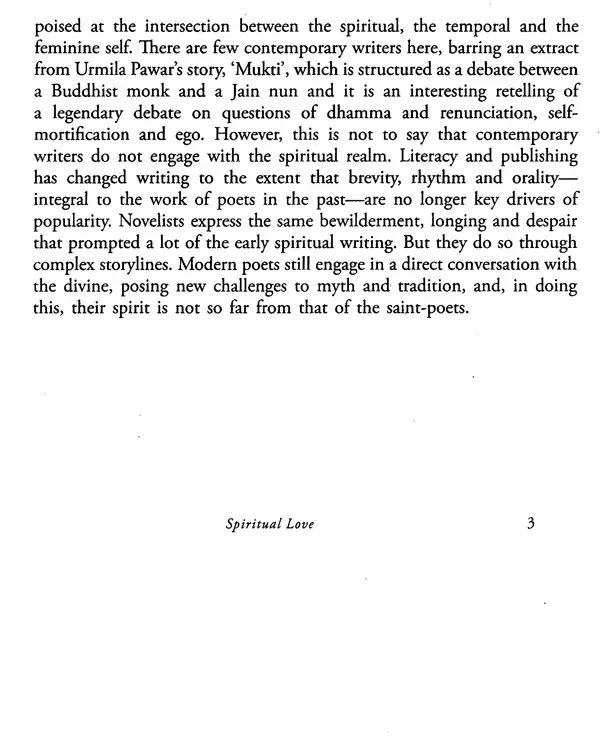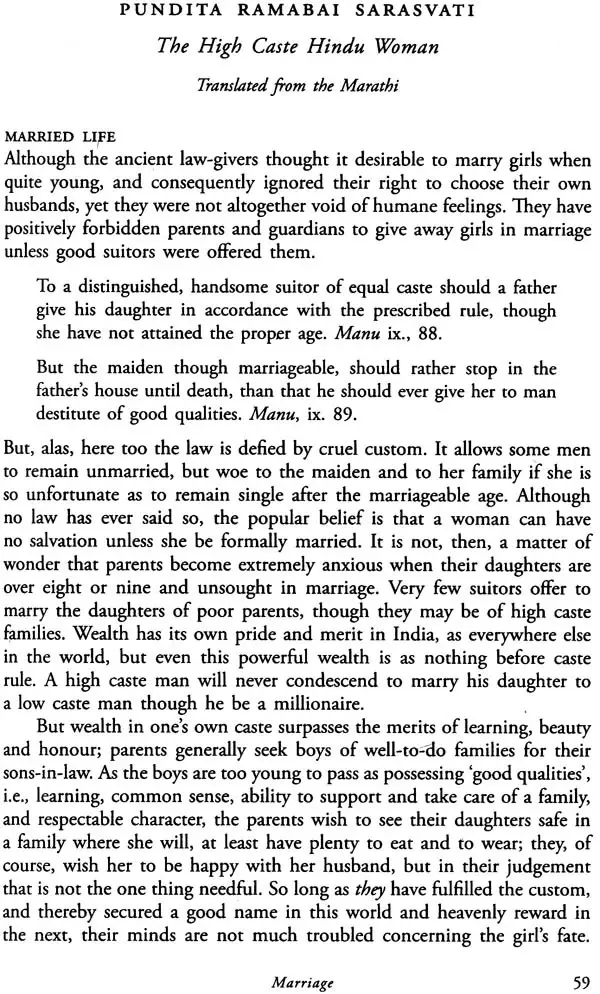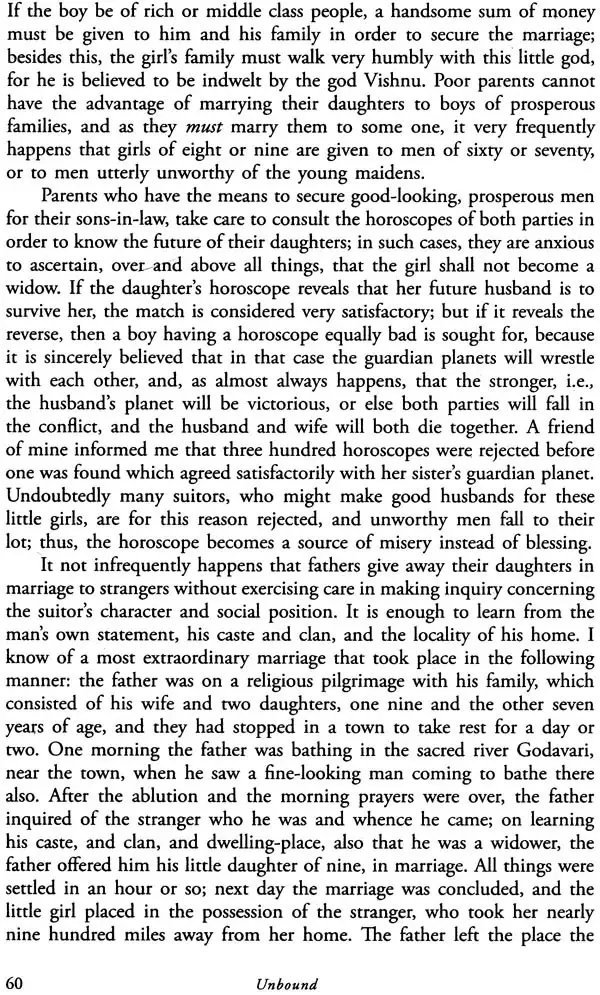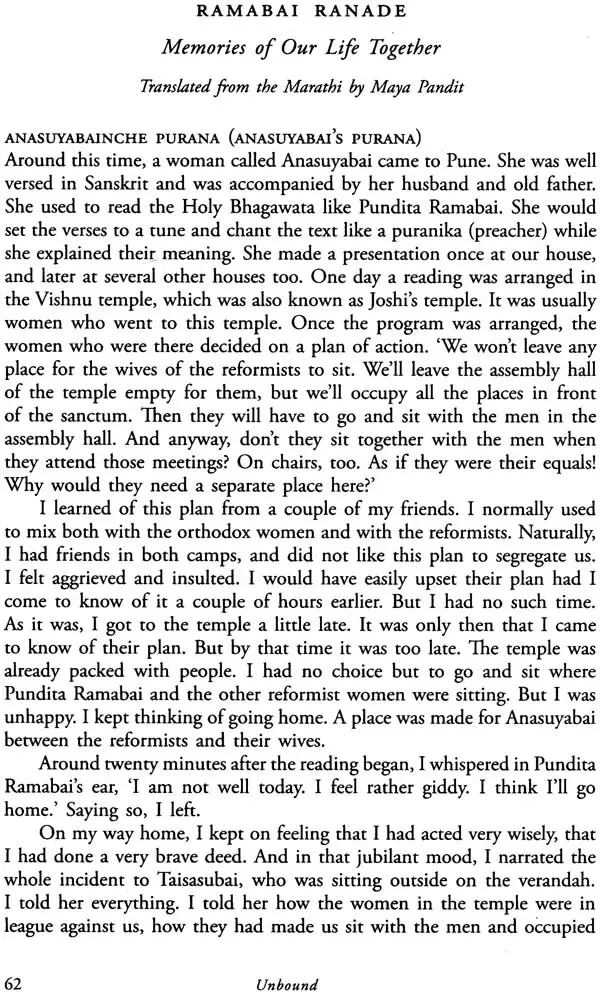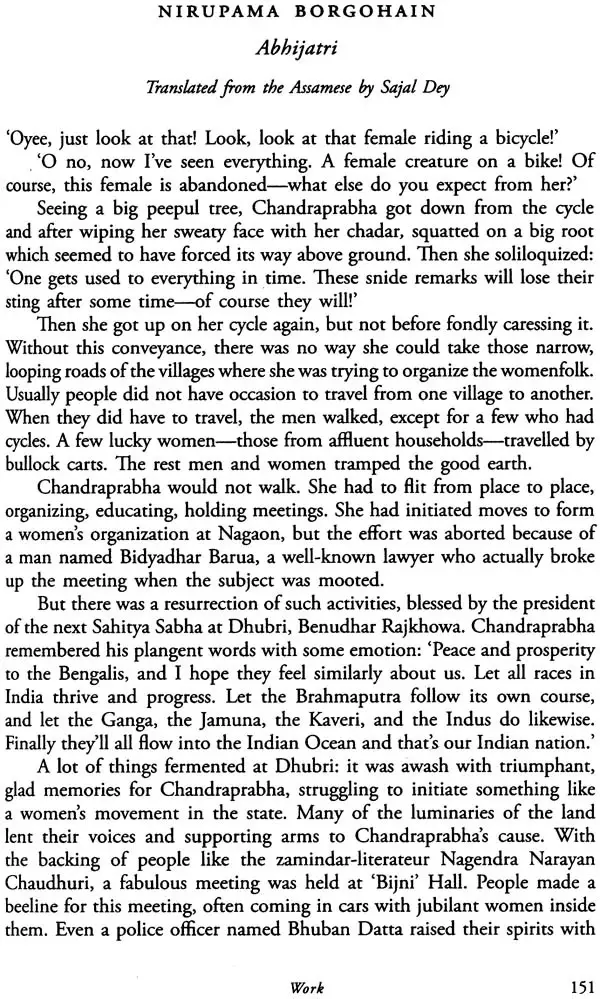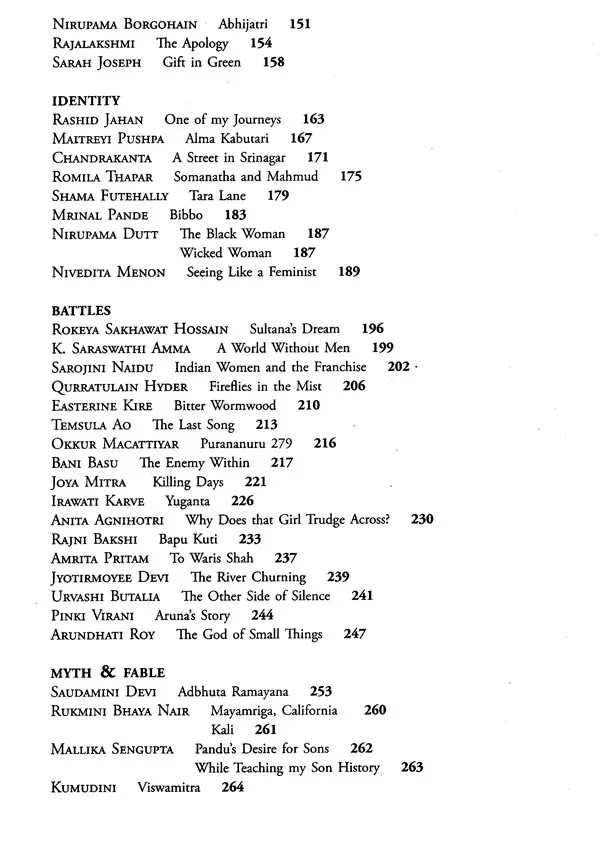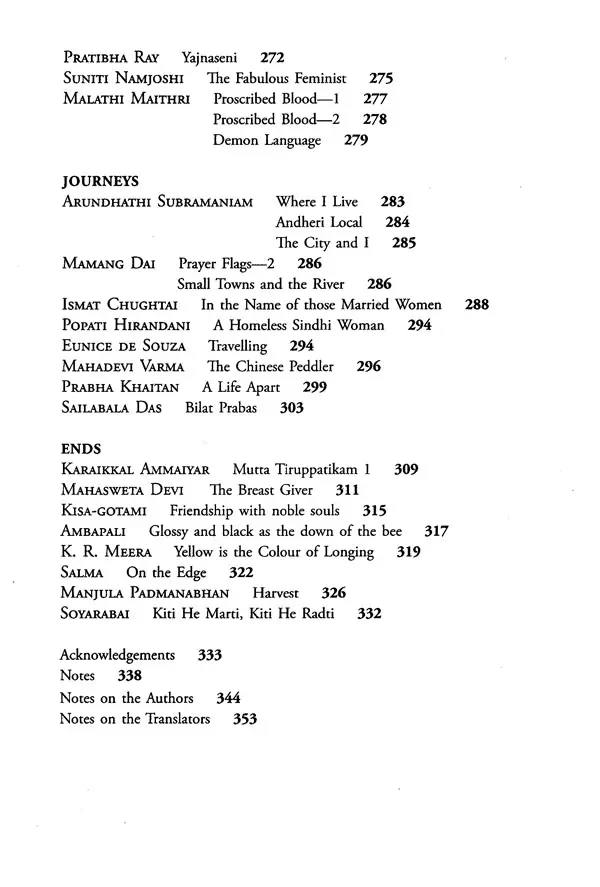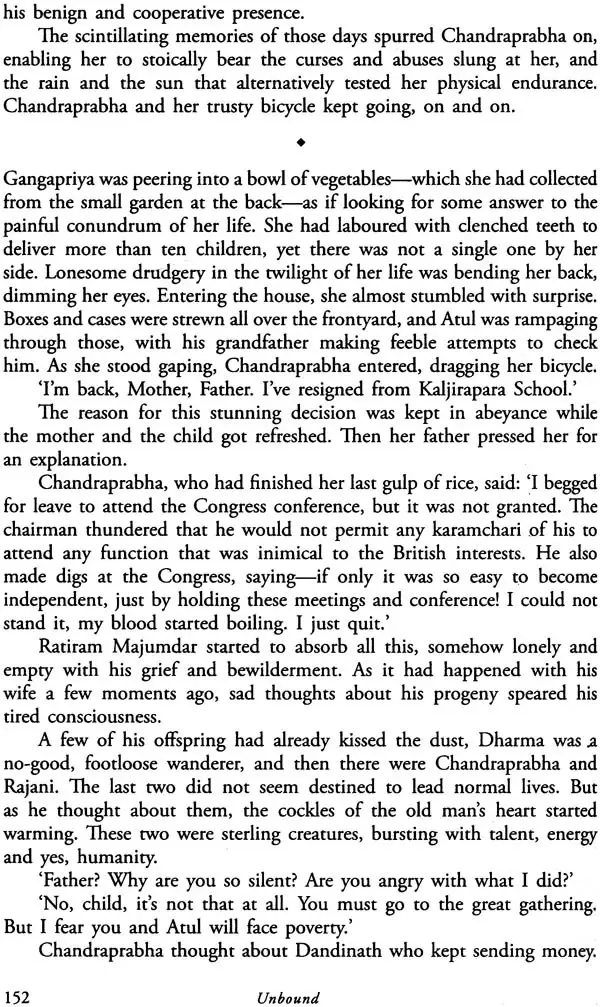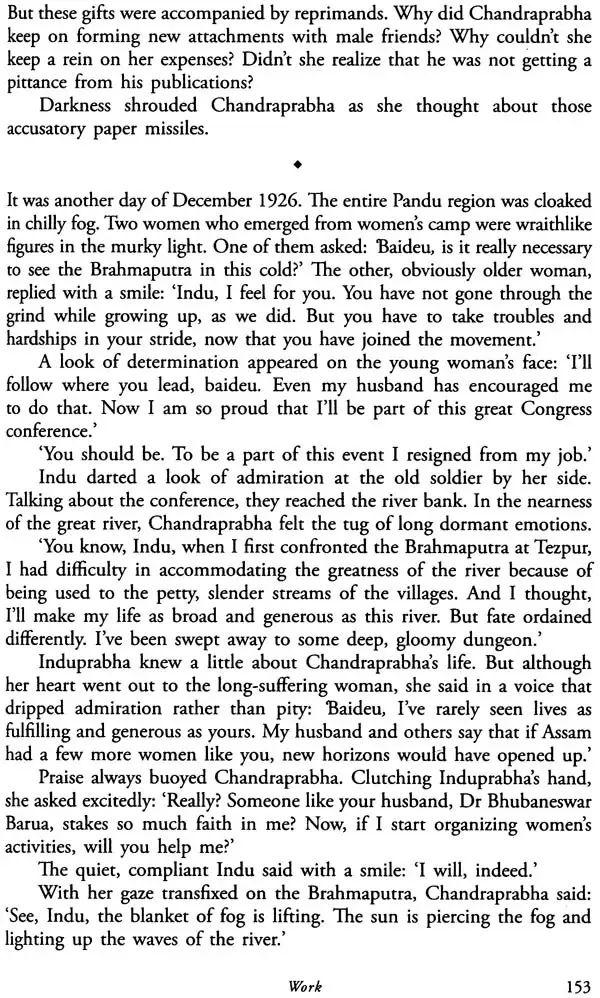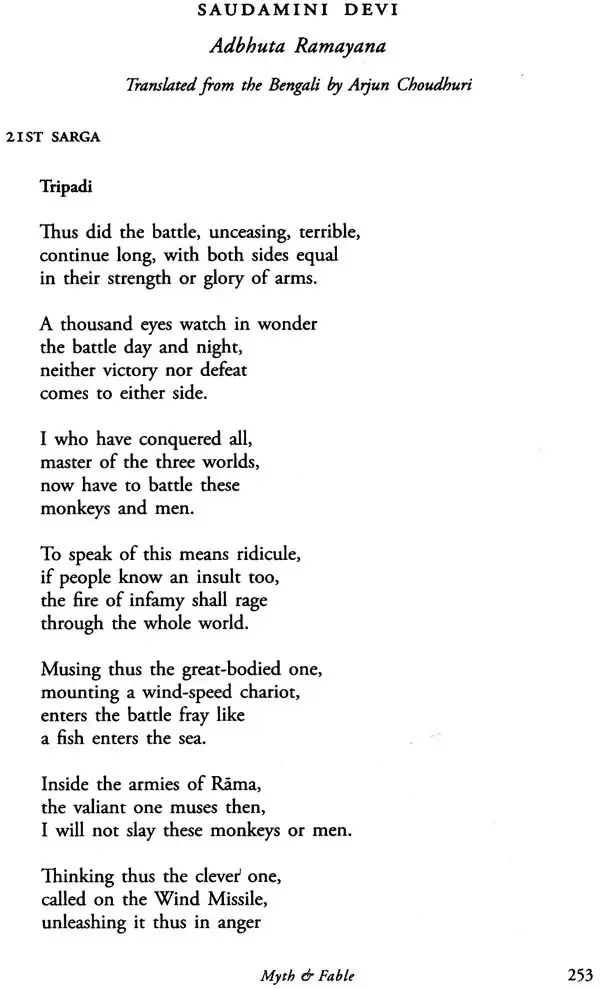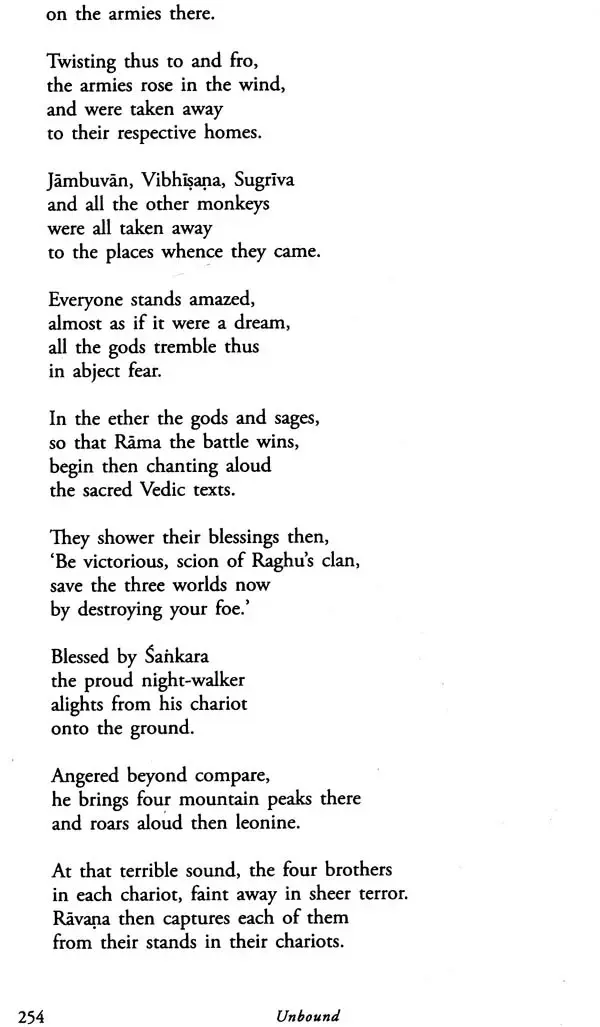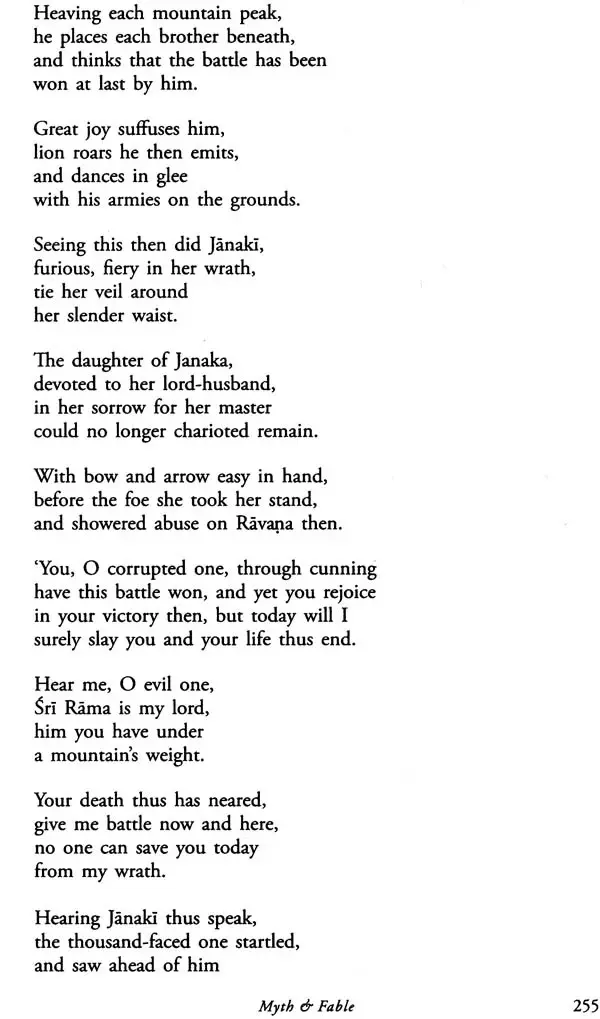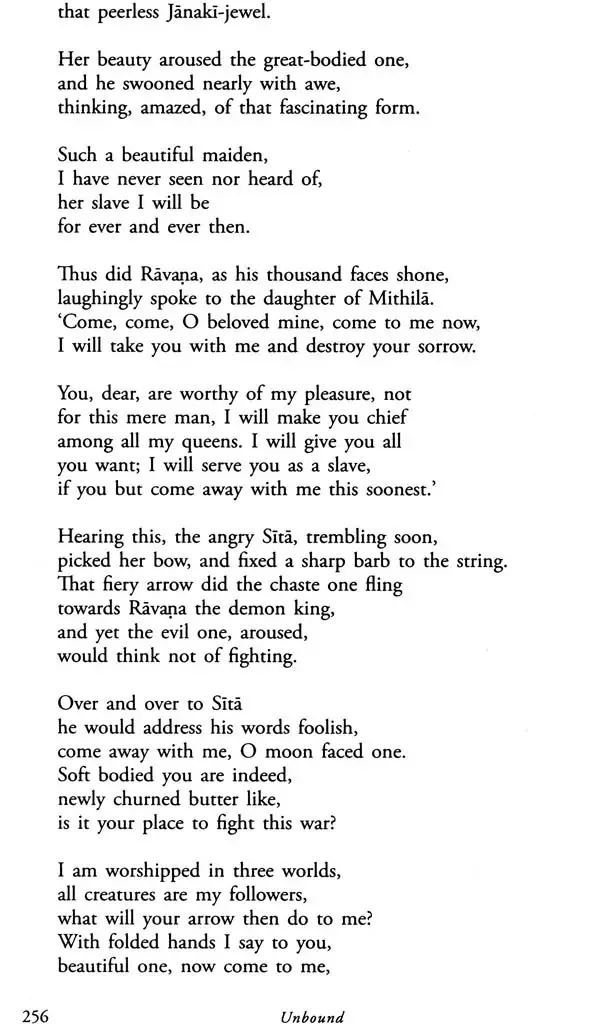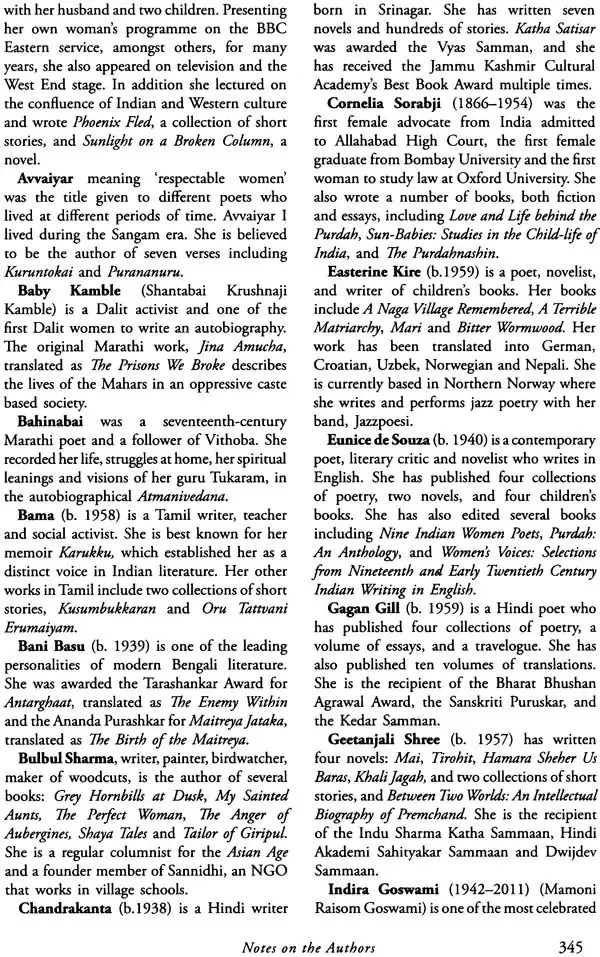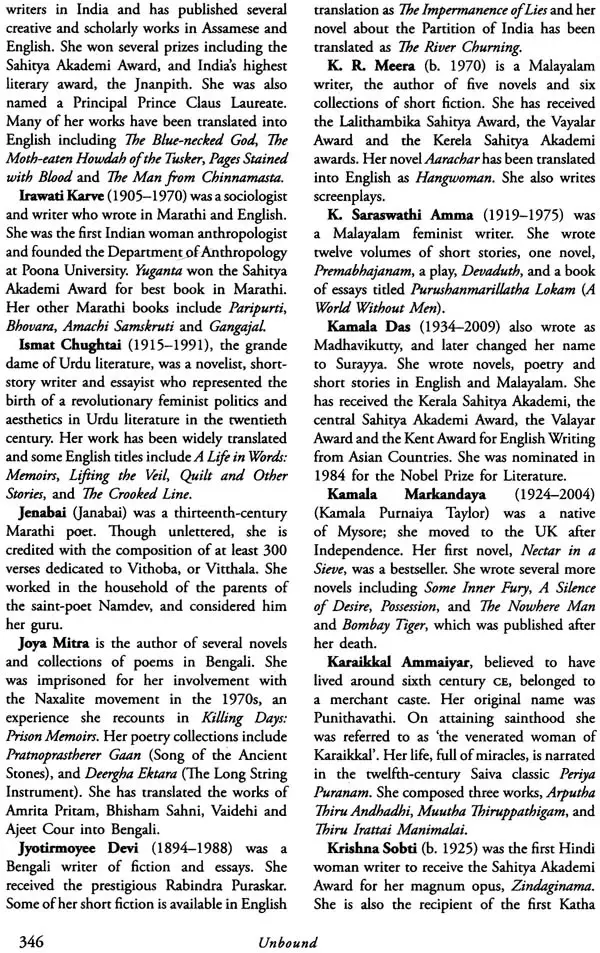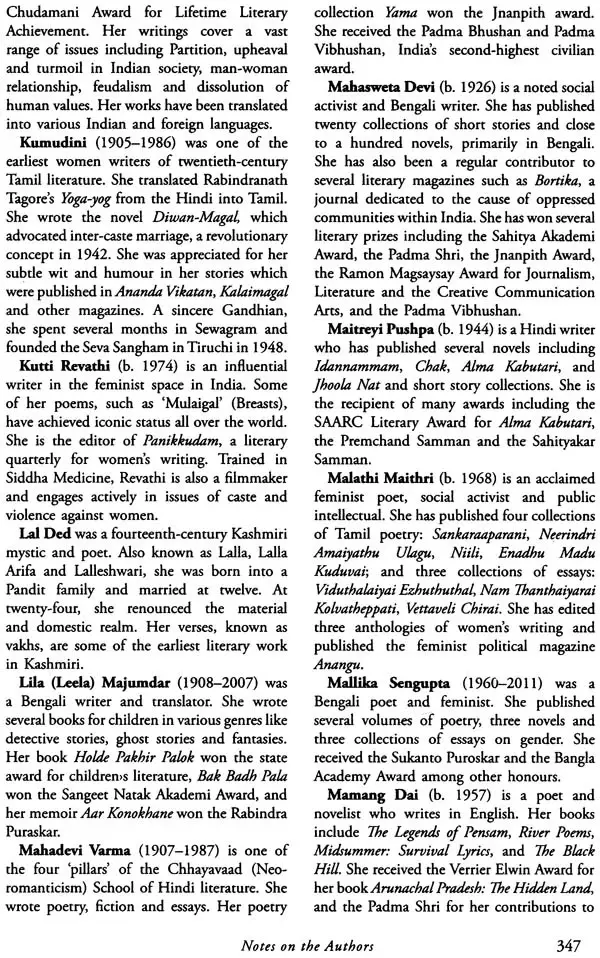
Unbound- 2,000 Years of Indian Women''s Writing
Book Specification
| Item Code: | UAG392 |
| Author: | Annie Zaidi |
| Publisher: | Aleph Book Company |
| Language: | English |
| Edition: | 2015 |
| Pages: | 373 |
| Cover: | HARDCOVER |
| Other Details | 9.00 X 6.00 inch |
| Weight | 480 gm |
Book Description
Unbound is a collection of some of the most significant writing by Indian women over the past two thousand years. Divided into eleven sections, it encompasses writing on various aspects of life: spirituality, love marriage, children, food, work, social and individual identity, battles, myths and fables, travel and death. While many of the pieces are commentaries on the struggle that women undertake to overcome obstacles-social and political-all of them showcase the remarkable creative ability of their creators. The term ‘women’s writing’ has often been used to limit and stereotype the work of women writers. But it also has large and more constructive meaning, and that is the sense in which it has been used to inform and describe the context of the book. As Annie Zaidi explains in her introduction: ‘Women bring to their writing to truth of their bodies, and an enquiry into the different ways in which gender inequity shapes human experience’.
Selected from hundred of novels, memories, essays, short story collections and volumes of poetry that were either written in English or that have been translated into English, the pieces in this collection include the most distinctive and powerful voices from every era. There are verses from the Therigatha, written by Buddhist nuns (circa 300 BCE), and writing by poet saints like Andaal, Avvaiyar, Lal Ded, Mirabai; modern classics by writers like Ajet Cour, Amrita Pritam, Arundhati Roy, Attia Hosian, Bama, Bulbul Sharma, Irawati Karve, Ismat Chughtai, Kamala Das, Krishna Sobti, Mahasweta Devi, Manju Kapur, Mannu Bhandari, Mrinal Pande, Nayantara Sahgal, Pinki Virani, Qurratulain Hyder, Rashid Jahan, Romila Thapar, Sarojini Naidu, Saudamini Devi, Shivani; and powerful new voices from our time like Arundhathi Subramaniam, Nilanjana Ray and Nivedita Menon.
Annie Zaidi is the author of Gulab, Love Stories # 1 to 14, and Known Turf: Bantering with Bandits and Other True Tales, which was shortlisted for the Vodafone Crossword Book Award. She is the co-author of The Good Indian Girl and a book of illustrated poems, Crush. Her work has appeared in several anthologies like Eat the Sky; Drink the Ocean, Mumbai Noir, Dharavi, Women Changing India, and 21 Under 40.
An odd thing happened soon after I took on the daunting task of editing this anthology. I found myself inscribing my own name on the first pages of the books I had bought. As student, I was in the habit of writing my name in books I owned but over the years, the more I bought, the less ownership mattered. But now, again, I found myself wanting to stamp certain books as ‘mine’-ones by Krishna Sobti, Mahasweta Devi, Sivakami, Salma, Meera, Geetanjali Shree. As soon as I began to feel a kinship with the work, I’d write my name on the first page. I even wanted to make notes in the margins and underline passages with ink.
In this way, I discovered that I belong to the books as much as they belong to me. It was the same impulse that led to me scratch my name on rocks when I climbed the ills near my childhood home. It’s a way of saying: I was here. And on several pages written by the women represented in this book, I have found my own self.
When I began work on this project, I struggled with several questions. The biggest one: several women writes are celebrated not just as ‘women writers’ but as writers, period . Some have won the nation’s highest literary honours. Must we continue to put ‘women writers’ in a box of their own?
Part of the answer came as I read more and more Indian women. Women bring to their writing the truth of their bodies, and an enquiry into the different ways in which gender inequity shapes human experience (and destroys lives). Many women writers also place women protagonists at the centre of their work and many stories set within the household have the power to illuminate the ways in which women’s lives are shaped and controlled.
It is worth nothing here that there has been a sort of dismissal of ‘domestic’ fiction in the recent past. Editors and writers, male and female, have equated domestic themes with dullness, or the lack of imaginative daring. In fact, there was a time when I (and I’m squirming as I write this) used to say that I didn’t care much for ‘kitchenized’ fiction. It is look me strong the roots of my own bias were and how foolish our undermining of ‘domestic’ fiction.
Of course it’s domestic! Patriarchy is nothing if not domestic. Besides, there is more sex, violence, politics and overall drama in the average household than, say, the average office. Why are we surprised if domestic settings are chosen for fiction? Form such settings emerge stories of great rebellion-and poetry that directly challenges the myths fed to us over thousands of years.
Hindi writer Krishna Sobti had once said in an interview that she wants to have fun, to live and not just write. She also said that families and marriages were anti-art, anti-writing. Yet, it is marriage and family that form the basis of her own writing. Her delicately crafted, aurally delicious novel Dil-o-Danish (translated as ‘The Heart has its Reason’) is firmly domestic. It tells of endless manoeuvring by women as they struggle for economic security and personal dignity. And while the bold reclamation of a woman’s sexuality was one aspect of her novel Mitra Marjani (To Hell With You, Mitro), it was also the story of a joint family.
There have been periods in our literary history when it seemed women cared less about craft or form; all they wanted was to be heard. The argument against patriarchy could turn into a howl of rage, as in P. Sivakami’s tightly spun novels, or it could be a lucid, almost detached account of Indian women’s lives as seen in Mahadevi Varma’s essays. Kumudini was wittily subversive as was K. Saraswathi Amma; Rokeya Sakhawat Hossain’s anger was brushed with sardonic humour. Rassundri Devi’s account was quite simply that -an account of her life, where she expresses more gratitude than rage, while Baby Kamble, Bama, Joya Mitra and Devaki Nilayamgode wrote memoirs that reflect their consciousness as activists.
At various points in our history, the very act of reading and writing was a protest. Most Indians were illiterate but women’s literacy was actively discouraged, even prohibited. Only a few managed to document their lives. It is against this backdrop that the introduction to Ramabai Sarasvati’s The High Caste Hindu Woman says: ‘The silence of a thousand years has been broken…’ This is not entirely accurate, of course, for women in the thousand years preceding 1887 did write. But in 1887, it was rare for a high caste Hindu women to express herself in the public domain. To write fluently in English, to travel abroad and to be published in America was very, very rare.
The High Caste Hindu Woman remains relevant even today, speaking as it does about infanticide, establishing clear links between marriage, dowry, caste religious scripture and the violence done to little girls. A hundred and fifty years later, the sex ratio is still alarmingly low in several parts of the country and the government is still trying to stop female foeticide through law enforcement. Pundita Rambai’s descriptions of the woes of upper caste women ought to be read alongside Baby Kamble’s account of the lives of Dalit women, and Bama’s autobiography, Karukku. All of them speak of a cycle of oppression and the need for literacy and financial independence in order to break this vicious cycle.
India has come far since Independence but violence against women continues to be so common that only the most gruesome acts shake the average citizen out of his/her complacency Many activists now openly say that women must struggle for their freedom again. There is lot of hostility directed at those who are part of this struggle and the abuse directed at women writers is also a reflection of this hostility.
Contemporary writers have faced abuse ant treats after having written about bodies, sex and religious institutions. Tamil poets like Salma nad Kutti Revathi were accused of ‘obscenity’ and threatened with violence. Criticism is often accompanied by sexual abuse and his was painfully evident while I was looking for essays by historian Romila Thapar. I came upon a website discussing her work and one comment described her thus: ‘That BIYATCH Romila thapar is nothing but a whore of the commies’. It was both amusing and ad sad to realize that more money, better education and exposure (mainly to American culture, judging from the language used) has not rid our civilization of men who, unable to disprove a women’s scholarship, start to abuse her sexuality.
In recent years, we also had a senior academic declare in an interview that women writers (with reference to contemporary Hindi literature) are competing with each other to establish who is the greatest whore among them. This is not a far cry from the way male social reformers had, in the early twentieth century, called for a ban on the work of Muddupalani, calling it the work of a prostitute; Nagarathnamma the women artiste who salvaged the Telugu classic and republished it, was also dismissed as a prostitute.
Even today women are judged by a different set of social and moral standards than men. It is in this context that an Indian women must be read, alongside the generations that came before her. We cannot know what to do next unless we know what we have already done, or what was done to us. Ignorance of the past leads to contortions in our understanding of our present selves. For instance, I had grown up believing that there was something remarkably bold and progressive about the Indian political leadership of the pre-independence era. I was proud of the fact that women were given equal voting rights in a sovereign India. Which makes us better than the UK or the USA where women had to fight for it. What I did not know is that, initially, the plan was to offer only limited suffrage to Indian women. Reading Sarojini Naidu’s impassioned plea to an overwhelmingly male leadership was a real eye-opener. She appealed to their generosity, their sense of justice, even to their dedication to our traditional values. But what if there were no Sarojini Naidu? Would we be marching down the streets even today, chaining ourselves to the gates of Rashtrapati Bhavan, screaming for women’s right to vote?
Reading towards this anthology has been a way of looking at the distance Indian women have travelled. Interestingly, the writers themselves seemed to be constantly looking over their shoulders, grappling with a shared history. Myths are referenced, goddesses invoked, legends summoned forth for a conversation. Draupadi and Sita, Amrapali and Akka Mahadevi are addressed with familiarity, as if they were grandmothers lying down in an adjacent bedroom. Rukmini Bhaya Nair writes of Kali’s loneliness. Vaidehi writes in Parvati’s voice. Pratibha Ray’s Yajnaseni retells the Mahabarata in Draupadi’s voice. Amrita Pritam calls on Waris Shah. Many emerging writers, whose work is not represented here, mainly due to a severe space constraint, continue to build conversations with the past. Anamika, a contemporary Hindi poet, has written poems addressing Tulsi, Amrapali and Jusus Christ. Amruta Patil, an emerging graphic novelist, has written Adi Parva with Ganga as the narrator. The urge to re-retell the stories that defined our cultural roots is still strong.
Editing this anthology has also been a personal journey. Some books felt like a personal tryst with truth, philosophy and cultural identity. Some were bottled-up forebodings, full of cruel prescience. Others infected me with grey groping in the midst of bewildering change. Often, I would tweet a few lines as soon as I had read them. I couldn’t wait to share with the word a tiny fraction of what I had right now!
I am hoping to convey to you, dear reader, a portion of the joy, the rage, the comfort, the kinship that I have found. It was only after reading all these women writers that I was convinced of the need for this anthology, even though other anthologies already existed. The most significant one is an extensive two volume set edited by Susie Tharu and K. Lalita and I owe them a huge debt of gratitude. They documented all women writers whose authorship of a particular text could be established. Other anthology have appeared with an emphasis on language, genre ‘new’ voice; voices from the eighteenth or nineteen or centuries, saint-poets and so on.
This anthology does not seek to document all literary contributions by all Indian women. There are thousands of women writers and it is beyond the scope of a single volume top include them all. I expected to be able to include between eighty and ninety writers. I have done my best to represent each era and region but have limited my self to existing translation or those that are forthcoming shortly.
Apart from the problem of not being able to include all writers, in some cases, it was all but impossible to firmly establish authorship. The Rig Veda refers to female ‘rishis‘ like Ghosa, Lopamudrta, and Apala, but scholars do not seem to agree that they authored hymns or verse. I have heard of women like Bavri Saheb Sheikh Rangrejin and Tej who are believed to have written in the sixteenth and seventeenth centuries but could not finds books featuring their original work. It would take several lifetimes to rescue all he texts that have disappeared from print or have never been translated.
We do have access to verse in Prakrit, translated beautifully by Arvind Krishna Mehrotra in The Absent Traveller, which resonate powerfully thousands of years later. But while they are written in a feminine voice, and may have been written by women, there is no way to establish individual authorship and therefore I have not included them here. Matters are further complicated by the fact there is a definite tradition of men writing in the first person, from a female perspective. For the same reason, I chose not to include folk literature where it is not clear who the author is.
In trying to decide what to include, I also examined the question of Indianness’. Historically, India (Hindustan or Bharat) was an entity that shifted as kingdoms were won or lost, but it was contained mainly within the subcontinent. So, of course I have considered all writers who belong to the current map the India. Partition, like Rokeya Sakhawat Hossain. If they were born 1947 but most their writing was published in independent Pakistan or Bangladesh, I have left them out.
Many ‘Indian’ writers not only live abroad but were born, bred and educated in other nations. I cannot settle prickly questions about cultural versus national identity but I decided to go with some basic rules: I would not privilege Indian writings in English over other languages, especially cultural, mythological and political history; I would pick narratives set within India as far as possible. I have avoided diaspora writing, particularly if it is set in other nations.
Genres represented include poetry, drama, novels, short fiction and non-fiction. I tried to focus on writers whose body of work was not restricted to speeches, letters or newspapers columns. I also avoided diary extracts. I very reluctantly excluded the memoirs of Binodini Dasi, Hamsa Wadkar, Protima Bedi - I would urge readers to read those remarkable works. I grappled with the nation of ‘writer’ a long while and eventually decided that, at least for the twentieth century, I ought to focus on writers who created a body of work and not one book. The exceptions are texts the capture a slice of women’s history at times when reading and writing was strongly discouraged, if not forbidden, like Rassundari Devi’s and Ramabai Ranade’s memoires.
I read and considered the work of women playwrights where it was available in English translation but not include screenplays and narratives about the making of films. I do believe that film scripts may well be a literary genre of the future. But I also think that we must learn to read screenplays without reference to without access to, the audio- visual productions they lead to. We should be able to judge them on purely literary grounds, and that time has not yet come. We can, and do, read scripts written for the stage, regardless of the productions they resulted in.
Wherever decisions were difficult, I have weighed in on the side of literary craft and genre-bending abilities. Another deciding factor was the possession of distinctive voice, a definite way of observing the world and remarking upon it. This is what unites writers as disparate as Qurratulain Hyder, Ismat Chughtai, Irawati Karve, Nayantara Sahgal. Volga and Suniti Namjoshi. They have all pushed the boundaries of content and from while offering a fresh feminist perspective.
I must add that the selection of extracts reflects my own tastes. Apart from craft, I looked for novelty, empathy, a fresh perspective, great historical significance, insights into gender and literary longevity. This is one reasons I did not include newspapers or magazine articles (they often require readers to be familiar with the immediate news context) even though the writing of some young women journalists is brilliant and I’m looking forwards to the books they will write.
Some omissions still make me anxious. There are writers I definitely wanted to include - Ambai, Gogu Shyamala, Saniya, Mala Sen, Anita to use extracts from their work either due to length or budget constraints. The works of Utsa Patnaik, Vrinda Nabar, Ritu Menon, kamla Bhasin, Leila Seth on labour caste, law and gender are also essential reading ad I was tempted to include them. But if I went down that road, I would have had to do a volume devoted entirely to non-fiction writing Indian Women.
This anthology comprises a mix of all genres and forms, arranged thematically. I worked under the assumption that most writing falls into broad themes, like love, sex, religion, death, parenting, politics, food, travel. Thus the books would touch upon all things that matter to humanity while reflecting where a particular piece of writing belongs has long been a bewildering exercise. Take, for instance, the poems of Karaikkal Ammaiyar.
They are dedicated to the lord, so I initially placed them in the section on spiritual love. But on a second and third reading, it was clear that the work was firmly rooted in the body, the awareness of impending death and the terror of destruction accompanied by a clear-eyed love for the Lord of Destruction. Similarly, many of Lal Ded’s vakhs (verse: literally the word suggests an ‘utterance’) are about dealth or the body, the meaninglessness of shame, the quest for Shankara, and the need for escape. It would be easier, perhaps, to say what they’re not about rather than slot them into any single category.
The novels were equally slippery. I would sometimes place extracts from the same book, even the same chapter, under three different themes. Tae Indira Goswami’s The Blue-necked God where she says what needed saying about widows-starvation, predators, the foolishness of thwarting desire. It is an indictment of organized religion that values ritual over humanity. It is about poverty and plain but it is also full of passages that capture the peace and elevation women hope to find in Vrindavan. Kamala Markandaya’s Nectar in a Sieve is another complex story - a love story, a parenting story, a story of tentative industrialization and rural famine. In The Anger of Aubergines Bulbul Sharma explores women’s relationship to food, but, as a natural extension, many of those food stories are about bodies, desire, ageing.
I have also tried to pick extracts that converse with each other, dancing from one ‘ras’ to another, one shade of human experience to the next: from spiritual longing and religion to secular love and lust, marriage to motherhood, class and caste to political and administration.
Finally, let me turn to a quote attributed to Hindi-Urdu writer Premchand. He said that a writer’s task is not to entertain, or even to hold up a mirror to society; a writer bears a torch that lights over time. If we read a book a hundred, a thousand years after it was written, can it still light our way?
Having read the women who wrote in centuries past, I now believe the answer is yes! Yes, they continue to light our way ahead.
**Contents and Sample Pages**

